Biology:Blue-tongued skink
| Blue-tongued skinks | |
|---|---|
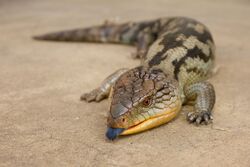
| |
| Blotched blue-tongued skink (Tiliqua nigrolutea) | |
| Scientific classification | |
| Domain: | Eukaryota |
| Kingdom: | Animalia |
| Phylum: | Chordata |
| Class: | Reptilia |
| Order: | Squamata |
| Family: | Scincidae |
| Subfamily: | Egerniinae |
| Genus: | Tiliqua Gray, 1825[1] |
| Species | |
|
8 extant, see text. | |
| Synonyms | |
|
Trachydosaurus | |
Blue-tongued skinks[2] comprise the Australasian genus Tiliqua, which contains some of the largest members of the skink family (Scincidae). They are commonly called blue-tongued lizards or simply blue-tongues or blueys in Australia or panana in Indonesia. As suggested by these common names, a prominent characteristic of the genus is a large blue tongue that can be bared as bluff-warning to potential enemies.[3] The type of predator/threat that is near will determine the intensity of colour present in the tongue. The tongue can also deform itself and produce a thick mucus in order to catch prey.[4] They are relatively shy in comparison with other lizards, and also significantly slower due to their shorter legs.
Systematics and distribution
Blue-tongued skinks are closely related to the genera Cyclodomorphus and Hemisphaeriodon. All species are found on mainland Australia with the exception of Tiliqua gigas, which occurs in New Guinea and various islands of Indonesia. The Tanimbar blue-tongued skink, a subspecies of Tiliqua scincoides, is also found on several small Indonesian islands between Australia and New Guinea. Tiliqua nigrolutea, the Blotched blue-tongued skink, is the only species present in Tasmania.
Ecology
Most species are diurnal, ground-foraging omnivores, feeding on a wide variety of insects, gastropods, flowers, fruits, and berries.[5] The pygmy blue-tongue is again the exception, being primarily an ambush predator of terrestrial arthropods.[6] All are viviparous, with litter sizes ranging from 1-4 in the pygmy blue-tongue and shingleback to 5-24 in the eastern and northern blue-tongues.[7]
Species
| Name | Scientific Name | Picture | Subspecies |
|---|---|---|---|
| Adelaide pygmy blue-tongue skink | T. adelaidensis (Peters, 1863) | 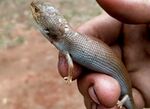
|
|
| No common name | T. frangens[8] | ||
| Indonesian blue-tongued skink | T. gigas (Schneider, 1801) | 
|
T. g. gigas, Giant blue-tongued skink; T. g. evanescens, Merauke blue-tongued skink; T. g. keyensis, Key Island blue-tongued skink |
| Centralian blue-tongued skink | T. multifasciata (Sternfeld, 1919) | 
|
|
| Blotched blue-tongued skink | T. nigrolutea (Quoy & Gaimard, 1824) | 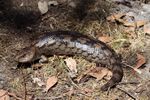
|
|
| Western blue-tongued skink | T. occipitalis (Peters, 1863) | 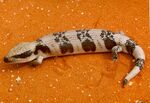
|
|
| Shingleback, bobtail | T. rugosa (Gray, 1825) | 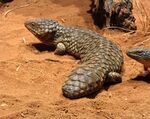
|
T. r. aspera, Eastern shingleback; T. r. konowi, Rottnest Island bobtail; T. r. palarra, Shark Bay bobtail; T. r. rugosa, Common shingleback, bobtail |
| Common blue-tongued skink | T. scincoides (White, 1790) | 
|
T. s. chimaerea, Tanimbar blue-tongued skink; T. s. intermedia, Northern blue-tongued skink; T. s. scincoides, Eastern blue-tongued skink |
| Irian Jaya blue-tongued skink | Tiliqua sp. | 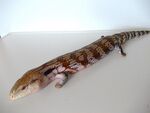
|
Extinct species
Multiple extinct species have been proposed. T. frangens, the largest known species of the genus, lived during the Pliocene and Pleistocene epoch around the Wellington Caves of New South Wales in Australia . Another extinct species T. laticephala may represent the same taxon as T. frangens. Its nearest relative is the extant T. rugosa, which is half the size and lacks the boney plates of T. frangens.[9][10][11]
Another extinct species T. wilkinsonorum also lived during the Pliocene epoch. The earliest possible species is T. pusilla from the middle Miocene, but researchers question whether this species belong to the genus Tiliqua due to its uncertain phylogenetic position that causes paraphyly.[9]
In captivity
Blue-tongues skink species are generally docile, gentle, quiet and easily tamed, and can make a good reptile pet for beginners. Although they are not aggressive, they have strong jaws and teeth, meaning that a bite from a skink can be painful. It is advisable not to startle or provoke them, as they may bite if they feel threatened.[12] Specimens can live up to 20 years or more.[13]
Notes
- ↑ Gray, J.E. (1825). A synopsis of the genera of reptiles and Amphibia, with a description of some new species. Annals of Philosophy 10:193—217. p. 201
- ↑ Tiliqua, Reptile Database
- ↑ Abramjan, Andran (2015). "Why is the tongue of blue-tongued skinks blue? reflectance of lingual surface and its consequences for visual perception by conspecifics and Predators". The Science of Nature 102 (7–8): 42. doi:10.1007/s00114-015-1293-4. PMID 26185113. Bibcode: 2015SciNa.102...42A.
- ↑ Tamara L. Smith; Kenneth V. Kardong; Vincent L. Bels (1999). "Prey Capture Behavior in the Blue-tongued Skink, Tiliqua scincoides". Journal of Herpetology 33 (3): 362–369. doi:10.2307/1565632. https://public.wsu.edu/~kkardong/Web%20of%20KVK_06b/Publications/skink.pdf. Retrieved 24 May 2022.
- ↑ Cogger, H.G. (2000). Reptiles and Amphibians of Australia. Reed New Holland.
- ↑ Department for Environment and Heritage > Pygmy Bluetongue Lizard - fact sheet, Environment.sa.gov.au, retrieved 18 July 2017
- ↑ Turner, G. 2001. Keeping Bluetongue Lizards. Australian Reptile Keeper Publications.
- ↑ Thorn, Kailah M.; Fusco, Diana A.; Hutchinson, Mark N.; Gardner, Michael G.; Clayton, Jessica L.; Prideaux, Gavin J.; Lee, Michael S. Y. (2023-06-14). "A giant armoured skink from Australia expands lizard morphospace and the scope of the Pleistocene extinctions" (in en). Proceedings of the Royal Society B: Biological Sciences 290 (2000). doi:10.1098/rspb.2023.0704. ISSN 0962-8452. PMID 37312544.
- ↑ 9.0 9.1 Thorn, K.M.; Fusco, D.A.; Hutchinson, M.N.; Gardner, M.G.; Clayton, J.L.; Prideaux, G.J.; Lee, M.S.Y. (2023). "A giant armoured skink from Australia expands lizard morphospace and the scope of the Pleistocene extinctions". Proceedings of the Royal Society of London B: Biological Sciences 290 (2000): 20230704. doi:10.1098/rspb.2023.0704. ISSN 1471-2954. PMID 37312544. Supplementary Information
- ↑ Extinct lizard was a bizarrely supersized version of modern skinks, Alice Klein, New Scientist, 2023-06-14
- ↑ Meet the biggest and most bizarre skink ever found in Australia. It became extinct 47,000 years ago, 2023-06-14
- ↑ "Feeding and Care of Your Blue-Tongued Skink". https://www.thesprucepets.com/pet-blue-tongued-skinks-1236897.
- ↑ "Blue-Tongued Skink - Tiliqua". https://www.petmd.com/reptile/species/blue-tongued-skink.
References
- Austin, J.J. & Arnold, E.N. (2006). Using ancient and recent DNA to explore relationships of extinct and endangered Leiolopisma skinks (Reptilia: Scincidae) in the Mascarene islands. Molecular Phylogenetics and Evolution 39(2): 503–511. doi:10.1016/j.ympev.2005.12.011 (HTML abstract)
- Bull, C.M. (1988). Mate fidelity in an Australian lizard Trachydosaurus rugosus (Scincidae). Copeia 1987(3): 749-757.
- Bull, C.M. (1990). Comparison of displaced and retained partners in a monogamous lizard Tiliqua rugosa. Australian Wildlife Research 17: 135-140.
- Valentic, R.A. (1996). A prey record of the Eastern Blue-tongue Tiliqua scincoides for the common brown snake Pseudonaja textilis. Monitor 8(3): 155.
External links
Wikidata ☰ Q883145 entry
 |

